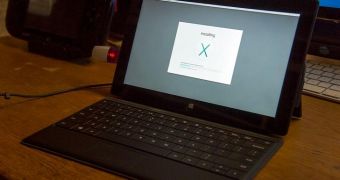Opinions are still mixed on whether the Surface Pro is a helpful device or not, but there's no doubt that as far as productivity on the go is concerned, Microsoft's first Windows 8 Pro tablet clearly comes in handy.
The Surface Pro, which was first launched in February 3, as well as the Surface Pro 2 and the Surface Pro 3 are all running the full version of Windows 8 and offer support for full desktop applications, which means that they're more or less capable of replacing your laptop quite easily.
But in case Windows 8 is not your cup of tea, there's always the option to install a different operating system, such as Mac OS X and Linux, as they both seem to be working on the Surface very smoothly.
As you can see in this photo published a couple of weeks ago on Twitter by Steve T-S, deploying Mac OS X on a Surface Pro is indeed possible, even though there are no details right now whether everything would work OK and the operating system has all drivers that the tablet needs in order to use it at its full potential.
Our resident Apple expert Filip Truta says that all Surface Pro tablets should be able to run Mac OS X since they're using an Intel CPU, so expect both the Pro 2 and the Pro 3 to be almost fully compatible with Apple's operating system, although some features might not work as expected.
Installing a different operating system on a Surface Pro, however, isn't quite a new concept. While the Surface RT does come with some limitations, also because it has an ARM processor, the Surface Pro and its successors allow users to deploy both Linux and Mac OS X by following almost the same steps as on a regular PC.
As far as Linux is concerned, for example, all you need is a live USB drive with Ubuntu or any other distribution you'd like. Just plug it into the USB port, shut down the tablet and keep volume down and power keys pressed until you get to see the Surface logo. Release them and you should be provided with several options, one of which would allow you to install the Linux distribution on the device.
Of course, make sure that you have enough space on your tablet before doing anything else and keep in mind that in some cases, not all features of the device are supported by the operating system.
For example, in the case of Linux, we've heard that the touch cover doesn't work as expected, although the kernel has recently been updated with support for both Touch and Type covers.
Obviously, we're still in the early stages of deploying a non-Windows platform on a Surface tablet, so expect more such tweaks to be released in the coming months.

 14 DAY TRIAL //
14 DAY TRIAL //